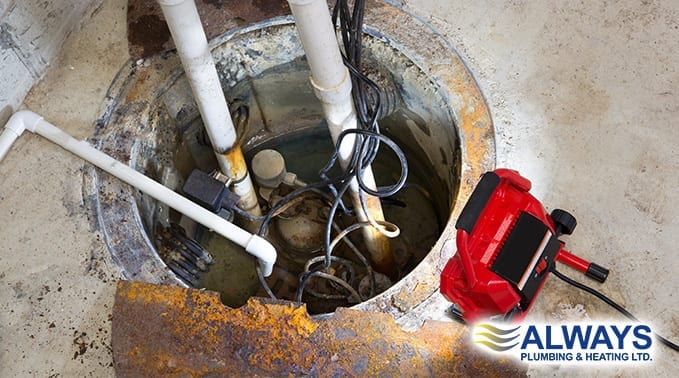Depending on where you live, a sump pump might be one of the most integral parts of equipment in your house – but there’s also a chance you’ll never need one at all. Some of you think, ‘Of course! I’d never go more than a few months without checking my sump pump, it’s too important.’ Others, though, say, ‘What on earth is a sump pump?’ If you fall into the second category, there’s a good chance you don’t need one. Unfortunately, Edmonton lies in a relatively flat area, so flooding is a problem; a sump pump is likely already in your home. On the off-chance you don’t have one, though, the pros at Always Plumbing & Heating have provided some guidelines to give you an idea of what you’d need to experience at home to invest in one.
What is a Sump Pump?
A sump pump is pretty self-explanatory: it’s a pump that is installed in the lowest point of your house – usually the basement – and it pumps out any water, sump, that accumulates when there is flooding. Some are activated via a pressure sensor, and others are triggered by a flotation activator. A sump pump uses centrifugal force to create a low-pressure environment to suck water in and force it out through a pipe that dumps it away from your home. A check valve prevents the water from trickling back through the pipe, ensuring it only funnels away from the pump.
How do I know if I need one?
To determine if you need a sump pump or not, you’ll need to figure out if your house is prone to accumulating water. Obviously, if floods are an issue in the area, you will definitely need one – but if you’re situated in an area without that danger, there’s still a chance you could house excess moisture. If there isn’t any standing water, or if your basement is completely dry, you’re probably safe. However, if moisture is present, run a de-humidifier in the basement and check for moisture again a few weeks later. If it’s still present, go ahead and invest in a sump pump.
Types of Sump Pumps
Sump Pumps are divided into two categories: Pedestal and submersible units.
- Pedestal sump pumps are installed above ground. They’re easier to install and perform maintenance on than submersible units are – and they’re cheaper! However, they can be affected by the water you’re trying to remove much easier than ones underground can.
- Submersible sump pumps can be covered with a lid, effectively making them impenetrable. We’d recommend going with this type, if only because there is a reduced risk of them being rendered inoperable since they are secluded.
Whichever one you choose, purchasing a backup battery-powered sump pump is an excellent idea. In the event your primary unit fails, the backup will keep chugging along and provide a critical contingency plan to keep your basement water-free. You’ll also want to install an alarm on your sump pump that will alert you if it fails – so you can take action before the high water gets too much to handle.
Before flood season hits, give the experts at Always Plumbing & Heating a call at 780-489-8118 (Edmonton) or 587-601-1253 (Fort McMurray) to get your sump pumps upgraded or replaced, or have us come out and take care of every step of the installation process. Our highly qualified technicians are available 24/7 throughout the year to take care of you, and it comes with a 100% Customer Satisfaction Guarantee!
